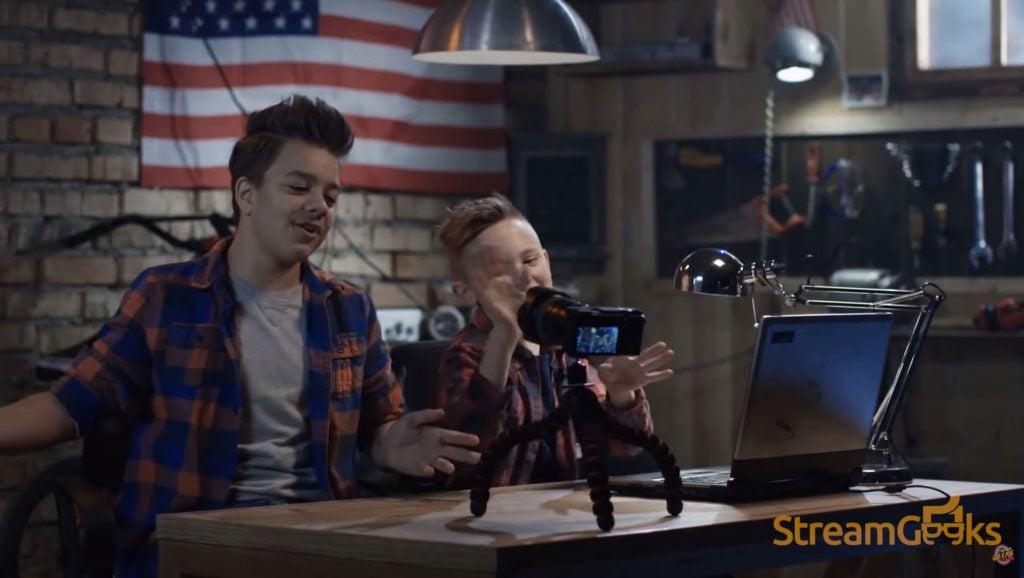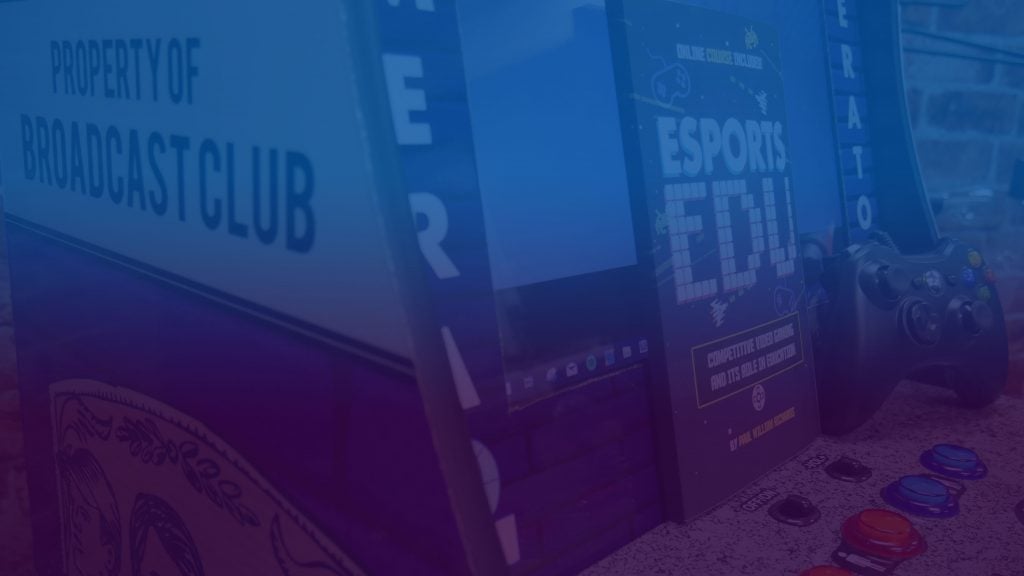How Broadcast Clubs use Graphic Design
Written by Paul Richards on April 29, 2019
Course Work: Graphic Design
Let’s discuss graphic design as it applies to live video production. For our online course, Tess is making a lower-third graphics overlay for a live video production we will be streaming from Castle La Bam at the end of this book. A lower third is a graphic that is used to display information in the lower third of the screen generally over a live camera feed. Lower thirds are perhaps the most commonly used graphic in video production and there are multiple types of lower thirds we will review.
Most video production software today has some sort of built-in title generator which allows producers to quickly edit the text that is shown on top of a selected lower third graphic. The lower third graphic is generally a .png media file with a transparent background. For this project, Tess will be using Adobe Photoshop to build a custom image overlay for our event.
Adobe Photoshop is a photo and graphic design tool for organizing multiple layers of visual assets. Creatively, Tess likes to start by drawing out exactly what her vision is on a sketchpad. Using a sketchpad outline, Tess will start to search online for image assets that she can use to build a graphic in Photoshop. An important tool that graphic designers use inside a Google search is the “labeled for reuse with modification” tool. This tool will sort images in your Google search based on whether or not the owner has labeled them for reuse. If they are labeled for reuse, you can use the graphics in your work legally by crediting the original author.
Another tool that graphic designers will often use are websites such as Freepik.com. Freepik.com is generally better than a simple Google image search because you can download complete Adobe Illustrator and Photoshop files. Each Illustrator file, for example, may include hundreds of layers that you can use to customize your newly created graphics. Just remember that in order to use a vector or an individual layer from a source like this, you must credit the original author. You can generally use these images for both personal and commercial projects as noted on the FreePik website. In order to credit the author, you must include a link to their work on your website, the broadcasts YouTube/Facebook OR provide credit to their work inside your video. This can easily be done on a blog post or inside the credits of your production. An example would be to include the credits inside a video outro by including the Authors user name and the website like this “Created by Katemangostar – Freepik.com.”
The graphics Tess is creating above is called a “Video Overlay.” It’s a combination of a traditional lower third graphic and a newer style of IRL “In Real Life” graphic. This graphic is designed to fit directly over a 16:9 aspect ratio workspace. Since our project will be designed for Full HD video, we will use a 1920 pixel wide by 1080-pixel tall canvas. Below you can see a list of the common 16:9 aspect ratio pixel resolutions:
| 16:9 Video Standards | Pixel Count |
| 720 | 1280×720 |
| 1080 | 1920×1080 |
| 4K | 3840×2160 |
When we are designing graphics for broadcast, it’s important to put them into the correct pixel size. When we open up Adobe Photoshop and create a new file, we will select the width and height of our documents canvas to match the resolution of our intended broadcast project. You will notice that Photoshop provides a “Film & Video” preset which includes easy one-click options to select the video type you are designing around.
Let’s take a look at some of the Photoshop tools we will use in this course to design a basic lower third file. If you do not have Photoshop, or you are using an alternative graphics design software, you should find that many of these tools work the same way. Alternatively, you can also use one of the included lower thirds templates available in your video production software.
Let’s start by choosing the HDTV 1080p template and click “OK.” You will notice that the project will start out with an all-white layer. We will want to use the “Eraser” (Shortcut E) tool to remove the white and create a transparent background which should look like a white and gray checkered pattern in most programs. Once we have a transparent background, we can go ahead and draw a shape in the bottom lower third of our canvas. You can do this with the “Shape Tool” (Shortcut U) and select a shape that you would like to create. You can draw a shape by clicking on the canvas and drawing out the dimensions you would like for this lower third. Once you have created a shape, you will notice a panel on the top of your workspace which allows you to customize your shapes options including fill, color, and stroke.
For this shape, you will select blue with no stroke. A stroke is a line around your shape that you can choose a color and width for. Now that you have your blue rectangle you could simply save this file as a .png and use it as the background for your lower third. But before we leave photoshop, let’s add a transparent gradient to this shape. In the right-hand side of Photoshop, you will see the main layer area. Inside the layers area, click the rectangle layer to make sure we have it selected. For organization inside Photoshop, it’s always best practice to name each layer by clicking the default name and customizing it. At the bottom of the layers area, you will see a square icon with a hole in it. This is the mask effect. Let’s add a mask to this layer and select the gradient tool (Shortcut G). This will allow us to create what is called a “Gradient Mask” over our blue rectangle. You will notice that clicking different starting points for the gradient mask will change the transparency effect. Let’s create a nice gradient layer and save this file as a .png so that the background will remain transparent when we import this file into OBS (Open Broadcaster Software).
Each video production software handles lower thirds differently. In this portion of our tutorial, we will use OBS (Open Broadcaster Software) which is the world’s most popular live streaming and video production software. This software is available for free on any Mac, PC or Linux computer. It’s worth noting that software such as vMix, Livestream and Wirecast do offer enhanced features that make lower third title management easier than OBS. When we open up your OBS software, you will be able to create a “new scene” using the plus button in the lower left-hand corner. Scenes are used to organize groups of media that are used together. For example, you may want to use one camera with a specific lower third graphics and another set of cameras with a different graphics overlay. For each of these sets of media, you will want to set up a unique scene. It’s best practice to name your scenes by right-clicking the scene and selected the “rename” option. You can name your scene whatever you like. I will name our example scene “Scene with Lower Third.” Inside the scene, we can add new sources such as cameras, videos, images and web browser inputs. Let’s add a camera feed or a sample picture to create our base layer. OBS uses a layering system that stacks each input on top of the next. You can move layers up and down inside your media stack by clicking the up and down arrows inside the source menu with the media you would like to move selected.
Now it’s time to add our .png lower third graphics file into our scene by clicking the plus button inside the sources area and selecting the image option. Next, we can name the input “Lower Third” and browse our computer to locate the .png file we saved from Photoshop. If you do not have access to Photoshop to create a file like this for yourself, you can find our practice files in the UDEMY course resources section. I’d also like to suggest a software called Gimp which is a completely free photoshop style program for Mac, PC and Linux computers. Now we should see our lower third graphic showing up on top. Let’s add some text over top of this layer by adding another new input, but this time we can select the “Text” type. OBS will open up a box we can use to enter in the text we would like to display, the font, and the color. Now we can drag and drop the text field to fit on top of our lower third.
Now let’s learn a little bit about OBS to demonstrate how to transition the lower third on and off during your production. First of all, don’t be surprised if the OBS version that you have does not look like the one pictured above. It’s worth checking if there is an updated version of OBS by clicking the “Help” drop-down menu and selecting “Check for Updates.” The latest version of OBS now includes a couple nifty new features you will want to start using. First of all, click “Studio Mode” to bring up a preview screen which you can use to transition between multiple scenes and configurations in your setup. If you like the darker gray colored theme we are using here, you can enable that in the settings menu under themes. Using “Studio Mode”, you can build a completely redesigned layout of your current scene by hiding or revealing new elements in the sources area. You can adjust what is being created in the preview screen before it is sent to the live output screen with a transition button. Once you have changed the scene by adding or removing your lower third, you can select a transition type to switch your preview screen to the output of your recording or live stream.
You might be wondering why we didn’t use Photoshop to add text into our lower third graphic. You certainly can use Photoshop to do this, but in this way, we can dynamically change the titles inside OBS as needed. As you are creating images and
video assets for your video production software, you always want to create media that can be used in multiple ways over time. Consider what your production software is capable of and design your media around the way you plan to use it during your live production.













